Are Psychophysiological Wearables Suitable for Comparing Pedagogical Teaching Approaches?
Abstract
:1. Introduction
Wearables in Education
2. Materials and Methods
2.1. Participants
2.2. Instrumentation
2.3. Study Protocol
2.4. Data Analysis
3. Results
3.1. Physiology and Teaching Approach
3.2. EDA Synchronization
4. Discussion
5. Conclusions
Author Contributions
Funding
Institutional Review Board Statement
Informed Consent Statement
Data Availability Statement
Acknowledgments
Conflicts of Interest
References
- Webster, C.A.; Russ, L.; Vazou, S.; Goh, T.L.; Erwin, H. Integrating movement in academic classrooms: Understanding, applying and advancing the knowledge base. Obes. Rev. 2015, 16, 691–701. [Google Scholar] [CrossRef]
- Routen, A.C. Should our children be sitting comfortably in school? BMJ 2011, 343, d4273. [Google Scholar] [CrossRef] [PubMed] [Green Version]
- Bucksch, J.; Sigmundova, D.; Hamrik, Z.; Troped, P.J.; Melkevik, O.; Ahluwalia, N.; Borraccino, A.; Tynjala, J.; Kalman, M.; Inchley, J. International Trends in Adolescent Screen-Time Behaviors From 2002 to 2010. J. Adolesc. Health 2016, 58, 417–425. [Google Scholar] [CrossRef] [PubMed]
- Hu, F.T.; Ginns, P.; Bobis, J. Getting the point: Tracing worked examples enhances learning. Learn. Instr. 2015, 35, 85–93. [Google Scholar] [CrossRef] [Green Version]
- Cotman, C.W.; Berchtold, N.C.; Christie, L.A. Exercise builds brain health: Key roles of growth factor cascades and inflammation. Trends Neurosci. 2007, 30, 464–472. [Google Scholar] [CrossRef]
- Jeon, Y.K.; Ha, C.H. The effect of exercise intensity on brain derived neurotrophic factor and memory in adolescents. Environ. Health Prev. Med. 2017, 22, 27. [Google Scholar] [CrossRef] [Green Version]
- Zhang, Q.; Li, L.; Guo, X.; Zheng, L.; Wu, Y.; Zhou, C. Implicit learning of symmetry of human movement and gray matter density: Evidence against pure domain general and pure domain specific theories of implicit learning. Int. J. Psychophysiol. 2020, 147, 60–71. [Google Scholar] [CrossRef]
- Kinoshita, H. Run for your brain’s life. Brain Work 1997, 7, 8. [Google Scholar]
- Ahmadiasl, N.; Alaei, H.; Hänninen, O. Effect of exercise on learning, memory and levels of epinephrine in rats’ hippocampus. J. Sport. Sci. Med. 2003, 2, 106–109. [Google Scholar]
- Chaddock-Heyman, L.; Erickson, K.I.; Kienzler, C.; Drollette, E.; Raine, L.; Kao, S.-C.; Bensken, J.; Weisshappel, R.; Castelli, D.M.; Hillman, C.; et al. Physical Activity Increases White Matter Microstructure in Children. Front. Neurosci. 2018, 12, 950. [Google Scholar] [CrossRef] [PubMed] [Green Version]
- Mullender-Wijnsma, M.; Hartman, E.; de Greeff, J.; Roel, J.; Doolaard, S.; Visscher, C. Improving Academic Performance of School-Age Children by Physical Activity in the Classroom: 1-Year Program Evaluation. J. Sch. Health 2015, 85, 365–371. [Google Scholar] [CrossRef] [PubMed]
- Gardner, H. Frames of Mind: The Theory of Multiple Intelligences; Basic Books: New York, NY, USA, 1983. [Google Scholar]
- Schusterman, R. Body Consciousness: A Philosophy of Mindfulness and Somaesthetics; Cambridge University Press: New York, NY, USA, 2008. [Google Scholar]
- Hannaford, C. Smart Moves: Why Learning Is Not All in Your Head; Great River Books: Salt Lake City, UT, USA, 2005. [Google Scholar]
- Kroflič, B. Creative Movement—the Third Dimension of Teaching (in Slovenian); Znanstveno in Publicistično Središče: Ljubljana, Slovenia, 1999. [Google Scholar]
- Gibbs, R.W. Embodiment and Cognitive Science; Cambridge University Press: Cambridge, UK, 2005. [Google Scholar]
- Lindgren, R.; Johnson-Glenberg, M. Emboldened by Embodiment: Six Precepts for Research on Embodied Learning and Mixed Reality. Educ. Res. 2013, 42, 445–452. [Google Scholar] [CrossRef]
- Sousa, D.A. Mind, Brain, and Education: The Impact of Educational Neuroscience on the Science of Teaching. Learn. Landsc. 2011, 5, 37–43. [Google Scholar] [CrossRef]
- Rinne, L.; Gregory, E.; Yarmolinskaya, J.; M, H. Why arts integration improves long-term retention of content. Mind Brain Educ. 2011, 5, 89–96. [Google Scholar] [CrossRef]
- Fink, A.; Graif, B.; Neubauer, A. Brain correlates underlying creative thinking: EEG alpha activity in professional versus novice dancers. Neuroimage 2009, 46, 854–862. [Google Scholar] [CrossRef] [PubMed]
- Thompson, E. Mind in Life: Biology, Phenomenology and the Sciences of Mind; Belknap Press: Cambridge, MA, USA, 2007. [Google Scholar]
- Geršak, V.; Geršak, G. A kinaesthetic approach to teaching electrical engineering. World Trans. Eng. Technol. Educ. 2016, 14, 366–373. [Google Scholar]
- Schultz, K.K.; Brackbill, M.L. Teaching electrocardiogram basics using dance and movement. Am. J. Pharm. Educ. 2009, 73, 70. [Google Scholar] [CrossRef] [Green Version]
- Lerman, Z.M. Chemistry: An Inspiration for Theatre and Dance. Chem. Educ. Int. 2005, 6, 1–5. [Google Scholar]
- Beck, M.M.; Lind, R.R.; Geertsen, S.S.; Ritz, C.; Lundbye-Jensen, J.; Wienecke, J. Motor-Enriched Learning Activities Can Improve Mathematical Performance in Preadolescent Children. Front. Hum. Neurosci. 2016, 10, 645. [Google Scholar] [CrossRef] [Green Version]
- Alibali, M.W.; Nathan, M.J. Embodiment in Mathematics Teaching and Learning: Evidence From Learners’ and Teachers’ Gestures. J. Learn. Sci. 2012, 21, 247–286. [Google Scholar] [CrossRef]
- Aubusson, P.; Fogwill, S.; Barr, R.; Perkovic, L. What happens when students do simulation-role-play in science? Res. Sci. Educ. 1997, 27, 565–579. [Google Scholar] [CrossRef]
- Geršak, V.; Geršak, G.; Drnovšek, J. Psychophysiological masurements in education. In Proceedings of the 20th IMEKO World Congress 2012, Busan, Korea, 9–14 September 2012; Volume 2, pp. 788–791. [Google Scholar]
- Ezenwoke, A.; Ezenwoke, O.; Adewumi, A.; Omoregbe, N. Wearable Technology: Opportunities and Challenges for Teaching and Learning in Higher Education in Developing Countries. In Proceedings of the INTED2016 10th International Technology, Education and Development Conference, Valencia, Spain, 7–9 March 2016; pp. 1872–1879. [Google Scholar]
- Horvers, A.; Tombeng, N.; Bosse, T.; Lazonder, A.W.; Molenaar, I. Detecting emotions through electrodermal activity in learning contexts: A systematic review. Sensors 2021, 21, 7869. [Google Scholar] [CrossRef]
- Zhang, Y.; Qin, F.; Liu, B.; Qi, X.; Zhao, Y.; Zhang, D. Wearable neurophysiological recordings in middle-school classroom correlate with students’ academic performance. Front. Hum. Neurosci. 2018, 12, 457. [Google Scholar] [CrossRef]
- Araya, R.; Sossa-Rivera, J. Automatic Detection of Gaze and Body Orientation in Elementary School Classrooms. Front. Robot. AI 2021, 8, 729832. [Google Scholar] [CrossRef] [PubMed]
- Antle, A.N.; Corness, G.; Droumeva, M. What the body knows: Exploring the benefits of embodied metaphors in hybrid physical digital environments. Interact. Comput. 2009, 21, 66–75. [Google Scholar] [CrossRef]
- Malmberg, J.; Haataja, E.; Seppänen, T.; Järvelä, S. Are we together or not? The temporal interplay of monitoring, physiological arousal and physiological synchrony during a collaborative exam. Int. J. Comput. Collab. Learn. 2019, 14, 467–490. [Google Scholar] [CrossRef] [Green Version]
- Giannakos, M.N.; Sharma, K.; Papavlasopoulou, S.; Pappas, I.O.; Kostakos, V. Fitbit for learning: Towards capturing the learning experience using wearable sensing. Int. J. Hum. Comput. Stud. 2020, 136, 102384. [Google Scholar] [CrossRef]
- Preece, S.J.; Goulermas, J.Y.; Kenney, L.P.J.; Howard, D.; Meijer, K.; Crompton, R. Activity identification using body-mounted sensors--a review of classification techniques. Physiol. Meas. 2009, 30, R1–R33. [Google Scholar] [CrossRef]
- Mardonova, M.; Choi, Y. Review of wearable device technology and its applications to the mining industry. Energies 2018, 11, 547. [Google Scholar] [CrossRef] [Green Version]
- Poh, M.-Z.; Swenson, N.C.; Picard, R.W. A wearable sensor for unobtrusive, long-term assessment of electrodermal activity. IEEE Trans. Biomed. Eng. 2010, 57, 1243–1252. [Google Scholar]
- Nakajima, M.; Lemieux, A.M.; Fiecas, M.; Chatterjee, S.; Sarker, H.; Saleheen, N.; Ertin, E.; Kumar, S.; al’Absi, M. Using novel mobile sensors to assess stress and smoking lapse. Int. J. Psychophysiol. 2020, 158, 411–418. [Google Scholar] [CrossRef] [PubMed]
- Sano, A.; Picard, R.W.; Stickgold, R. Quantitative analysis of wrist electrodermal activity during sleep. Int. J. Psychophysiol. 2014, 94, 382–389. [Google Scholar] [CrossRef] [PubMed]
- Thomaidou, C.; Konstantinidou, E.; Venetsanou, F. Effects of an eight-week creative dance and movement program on motor creativity and motor competence of preschoolers. J. Phys. Educ. Sport 2021, 21, 3268–3277. [Google Scholar]
- Fairclough, S.H.; Dobbins, C. Personal informatics and negative emotions during commuter driving: Effects of data visualization on cardiovascular reactivity & mood. Int. J. Hum. Comput. Stud. 2020, 14, 102499. [Google Scholar]
- Peake, J.M.; Kerr, G.; Sullivan, J.P. A critical review of consumer wearables, mobile applications, and equipment for providing biofeedback, monitoring stress, and sleep in physically active populations. Front. Physiol. 2018, 9, 743. [Google Scholar] [CrossRef] [PubMed]
- St-Onge, M.; Mignault, D.; Allison, D.B. Evaluation of a portable device to measure daily energy expenditure. Am. J. Clin. Nutr. 2007, 85, 742–749. [Google Scholar] [CrossRef] [Green Version]
- Teller, A. A platform for wearable physiological computing. Interact. Comput. 2004, 16, 917–937. [Google Scholar] [CrossRef]
- Rodgers, M.M.; Pai, V.M.; Conroy, R.S. Recent advances in wearable sensors for health monitoring. IEEE Sens. J. 2015, 15, 3119–3126. [Google Scholar] [CrossRef]
- Iqbal, M.H.; Aydin, A.; Brunckhorst, O.; Dasgupta, P.; Ahmed, K. A review of wearable technology in medicine. J. R. Soc. Med. 2016, 109, 372–380. [Google Scholar] [CrossRef]
- Zheng, Y.L.; Ding, X.R.; Poon, C.C.Y.; Lo, B.P.L.; Zhang, H.; Zhou, X.L.; Yang, G.Z.; Zhao, N.; Zhang, Y.T. Unobtrusive sensing and wearable devices for health informatics. IEEE Trans. Biomed. Eng. 2014, 61, 1538–1554. [Google Scholar] [CrossRef] [PubMed]
- Sharif, M.M.; Bahammam, A.S. Sleep estimation using BodyMedia’s SenseWearTM armband in patients with obstructive sleep apnea. Ann. Thorac. Med. 2013, 8, 53–57. [Google Scholar] [PubMed]
- Lisetti, C.L.; Nasoz, F. Using Noninvasive Wearable Computers to Recognize Human Emotions from Physiological Signals. EURASIP J. Adv. Signal Process. 2004, 2004, 1672–1687. [Google Scholar] [CrossRef] [Green Version]
- Dindar, M.; Kirschner, P.A.; Haataja, E. Matching self-reports with electrodermal activity data: Investigating temporal changes in self-regulated learning. Educ. Inf. Technol. 2020, 25, 1785–1802. [Google Scholar] [CrossRef] [Green Version]
- Carroll, A.; Gillies, R.M.; Cunnington, R.; McCarthy, M.; Sherwell, C.; Palghat, K.; Goh, F.; Baffour, B.; Bourgeois, A.; Rafter, M.; et al. Changes in science attitudes, beliefs, knowledge and physiological arousal after implementation of a multimodal, cooperative intervention in primary school science classes. Inf. Learn. Sci. 2019, 120, 409–425. [Google Scholar] [CrossRef]
- van der Mee, D.J.; Gevonden, M.J.; Westerink, J.H.D.M.; de Geus, E.J.C. Validity of electrodermal activity-based measures of sympathetic nervous system activity from a wrist-worn device. Int. J. Psychophysiol. 2021, 168, 52–64. [Google Scholar] [CrossRef] [PubMed]
- Henrie, C.R.; Halverson, L.R.; Graham, C.R. Measuring student engagement in technology-mediated learning: A review. Comput. Educ. 2015, 90, 36–53. [Google Scholar] [CrossRef]
- Geršak, G.; Ogorevc, J.; Drnovšek, J. Stroop test—A reference stimulus for psychophysiological measurements? In Proceedings of the 20th IMEKO World Congress 2012, Busan, Korea, 9–14 September 2012; Volume 1, pp. 637–640. [Google Scholar]
- Jurak, G.; Sorić, M.; Starc, G.; Kovač, M.; Mišigoj-Duraković, M.; Borer, K.; Strel, J. School day and weekend patterns of physical activity in urban 11-year-olds: A cross-cultural comparison. Am. J. Hum. Biol. 2015, 27, 192–200. [Google Scholar] [CrossRef] [Green Version]
- Attallah, B.; Ilagure, Z. Wearable Technology: Facilitating or Complexing Education? Int. J. Inf. Educ. Technol. 2018, 8, 433–436. [Google Scholar] [CrossRef] [Green Version]
- Geršak, V.; Vitulić, H.S.; Prosen, S.; Starc, G.; Humar, I.; Geršak, G. Use of wearable devices to study activity of children in classroom; Case study—Learning geometry using movement. Comput. Commun. 2020, 150, 581–588. [Google Scholar] [CrossRef]
- Peter, C.; Ebert, E.; Beikirch, H. Affective Computing and Intelligent Interaction; Springer: Berlin/Heidelberg, Germany, 2005; Volume 3784, ISBN 978-3-540-29621-8. [Google Scholar]
- Geršak, G.; Drnovšek, J. Sensewear body monitor in psychophysiological measurements. In Proceedings of the IFMBE XIV Mediterranean Conference on Medical and Biological Engineering and Computing 2016, Paphos, Cyprus, 31 March–2 April 2016; Volume 57. [Google Scholar]
- Peter, C.; Ebert, E.; Beikirch, H. A wearable multi-sensor system for mobile acquisition of emotion-related physiological data. In Proceedings of the International Conference on Affective Computing and Intelligent Interaction 2005, Beijing, China, 22–14 October 2018; Volume 3784 LNCS, pp. 691–698. [Google Scholar]
- Csikszentmihalyi, M. Flow and the Psychology of Discovery and Invention; HarperPerennial: New York, NY, USA, 1997. [Google Scholar]
- Darzi, A.; Novak, D. Using physiological linkage for patient state assessment in a competitive rehabilitation game. IEEE Int. Conf. Rehabil. Robot. 2019, 2019, 1031–1036. [Google Scholar]
- Coutinho, J.; Oliveira-Silva, P.; Mesquita, A.R.; Barbosa, M.; Perrone-McGovern, K.M.; Gonçalves, O.F. Psychophysiological Reactivity in Couples During a Marital Interaction Task. Appl. Psychophysiol. Biofeedback 2017, 42, 335–346. [Google Scholar] [CrossRef] [PubMed]
- Marci, C.D.; Ham, J.; Moran, E.; Orr, S.P. Physiologic correlates of perceived therapist empathy and social-emotional process during psychotherapy. J. Nerv. Ment. Dis. 2007, 195, 103–111. [Google Scholar] [CrossRef]
- Sato, W.; Kochiyama, T.; Yoshikawa, S. Physiological correlates of subjective emotional valence and arousal dynamics while viewing films. Biol. Psychol. 2020, 157, 107974. [Google Scholar] [CrossRef]
- Csíkszentmihályi, M. Flow: The Psychology of Optimal Experience; Harper Perennial: New York, NY, USA, 2008. [Google Scholar]
- Gillies, R.M.; Carroll, A.; Cunnington, R.; Rafter, M.; Palghat, K.; Bednark, J.; Bourgeois, A. Multimodal representations during an inquiry problem-solving activity in a Year 6 science class: A case study investigating cooperation, physiological arousal and belief states. Aust. J. Educ. 2016, 60, 111–127. [Google Scholar] [CrossRef]
- Welk, G.J.; McClain, J.J.; Eisenmann, J.C.; Wickel, E.E. Field validation of the MTI Actigraph and BodyMedia armband monitor using the IDEEA monitor. Obesity 2007, 15, 918–928. [Google Scholar] [CrossRef] [Green Version]
- Hernandez, J.; Riobo, I.; Rozga, A.; Abowd, G.D.; Picard, R.W. Using electrodermal activity to recognize ease of engagement in children during social interactions. In Proceedings of the 2014 ACM International Joint Conference on Pervasive and Ubiquitous Computing, Seattle, WA, USA, 13–17 September 2014; pp. 307–317. [Google Scholar]
- Papazoglou, D.; Augello, G.; Tagliaferri, M.; Savia, G.; Marzullo, P.; Maltezos, E.; Liuzzi, A. Evaluation of a multisensor armband in estimating energy expenditure in obese individuals. Obesity 2006, 14, 2217–2223. [Google Scholar] [CrossRef] [Green Version]
- Liden, C.B.; Wolowicz, M.; Des, J.S.M.; Teller, A.; Vishnubhatla, S.; Pelletier, R.; Farrington, J. Accuracy and Reliability of the SenseWear TM Armband as an Energy Expenditure Assessment Device; BodyMedia, Inc.: Pittsburgh, PA, USA, 2002; pp. 1–15. [Google Scholar]
- Calabro, M.A.; Lee, J.M.; Saint-Maurice, P.F.; Yoo, H.; Welk, G.J. Validity of physical activity monitors for assessing lower intensity activity in adults. Int. J. Behav. Nutr. Phys. Act. 2014, 11, 119. [Google Scholar] [CrossRef] [Green Version]
- Ogorevc, J.; Geršak, G.; Novak, D.; Drnovšek, J. Metrological evaluation of skin conductance measurements. Meas. J. Int. Meas. Confed. 2013, 46, 2993–3001. [Google Scholar] [CrossRef]
- Powell, C.; Carson, B.P.; Dowd, K.P.; Donnelly, A.E. The accuracy of the SenseWear Pro3 and the activPAL3 Micro devices for measurement of energy expenditure. Physiol. Meas. 2016, 37, 1715–1727. [Google Scholar] [CrossRef] [PubMed]
- de Almeida Mendes, M.; da Silva, I.; Ramires, V.; Reichert, F.; Martins, R.; Ferreira, R.; Tomasi, E. Metabolic equivalent of task (METs) thresholds as an indicator of physical activity intensity. PLoS ONE 2018, 13, e0200701. [Google Scholar]
- Davies, J.; Brember, I. The Reliability and Validity of the ‘Smiley’ Scale. Br. Educ. Res. J. 1994, 20, 447–454. [Google Scholar] [CrossRef]
- Balon, A.; Gostinčar Blagotinšek, A.; Papotnik, A.; Skribe Dimec, D. Vodopivec, I. Curriculum, Program of Primary School, Science and Technology; National Education Institute Slovenia: Ljubljana, Slovenia, 2011. (In Slovenian) [Google Scholar]
- Pavlin, J.; Čampa, T. Is peer instruction in primary school feasible?: The case study in Slovenia. Eur. J. Educ. Res. 2021, 10, 785–798. [Google Scholar] [CrossRef]
- Novljan, M.; Pavlin, J. Experiences of Slovenian In-Service Primary School Teachers and Students of Grades 4 and 5 with Outdoor Lessons in the Subject Science and Technology. Cent. Educ. Policy Stud. J. 2021, 12, 189–215. [Google Scholar] [CrossRef]
- Geršak, G.; Drnovšek, J. Electrodermal activity patient simulator. PLoS ONE 2020, 15, e0228949. [Google Scholar] [CrossRef]
- Braithwaite, J.J.; Watson, D.G.; Jones, R.; Rowe, M. A Guide for Analysing Electrodermal Activity (EDA) & Skin Conductance Responses (SCRs) for Psychological Experiments; University of Birmingham: Birmingham, UK, 2015. [Google Scholar]
- Boucsein, W. Electrodermal Activity, 2nd ed.; Springer London: London, UK, 2012; ISBN 9781461411253. [Google Scholar]
- Marci, C.D.; Orr, S.P. The effect of emotional distance on psychophysiologic concordance and perceived empathy between patient and interviewer. Appl. Psychophysiol. Biofeedback 2006, 31, 115–128. [Google Scholar] [CrossRef]
- Pallant, J. SPSS Survival Manual: A Step by Step Guide to Data Analysis Using SPSS, 4th ed.; Allen & Unwin: Crows Nest, NSW, Australia, 2011. [Google Scholar]
- Hake, R.R. Interactive-engagement versus traditional methods: A six-thousand-student survey of mechanics test data for introductory physics courses. Am. J. Phys. 1998, 66, 64–74. [Google Scholar] [CrossRef] [Green Version]
- McKagan, S.; Sayre, E.; Madsen, A. Normalized Gain: What Is It and When and How Should I Use it? Available online: https://www.physport.org/recommendations/Entry.cfm?ID=93334 (accessed on 29 July 2022).
- Pijeira-Díaz, H.J.; Drachsler, H.; Kirschner, P.A.; Järvelä, S. Profiling sympathetic arousal in a physics course: How active are students? J. Comput. Assist. Learn. 2018, 34, 397–408. [Google Scholar] [CrossRef] [Green Version]
- Sahakyan, L.; Kelley, C.M. A Contextual Change Account of the Directed Forgetting Effect. J. Exp. Psychol. Learn. Mem. Cogn. 2002, 28, 1064–1072. [Google Scholar] [CrossRef] [PubMed]
- Novak, D.; Mihelj, M.; Munih, M. Psychophysiological responses to different levels of cognitive and physical workload in haptic interaction. Robotica 2011, 29, 367–374. [Google Scholar] [CrossRef] [Green Version]
- Bellato, A.; Arora, I.; Hollis, C.; Groom, M.J. Is autonomic nervous system function atypical in attention deficit hyperactivity disorder (ADHD)? A systematic review of the evidence. Neurosci. Biobehav. Rev. 2020, 108, 182–206. [Google Scholar] [CrossRef]
- Osgood-Campbell, E. Investigating the educational implications of embodied cognition: A model interdisciplinary inquiry in mind, brain, and education curricula. Mind Brain Educ. 2015, 9, 3–9. [Google Scholar] [CrossRef]
- Schunk, D.H.; Pintrich, P.R.; Meece, J.L. Motivation in Education: Theory, Research, and Applications, 3rd ed.; Pearson/Merrill Prentice Hall: Upper Saddle River, NJ, USA, 2008. [Google Scholar]
- Hidi, S. An interest researcher’s perspective: The effects of extrinsic and intrinsic factors on motivation. In Intrinsic and Extrinsic Motivation: The Search for Optimal Motivation and Performance; Sansone, C., Harackiewicz, J.M., Eds.; Academic Press: San Diego, CA, USA, 2000; pp. 309–339. [Google Scholar]
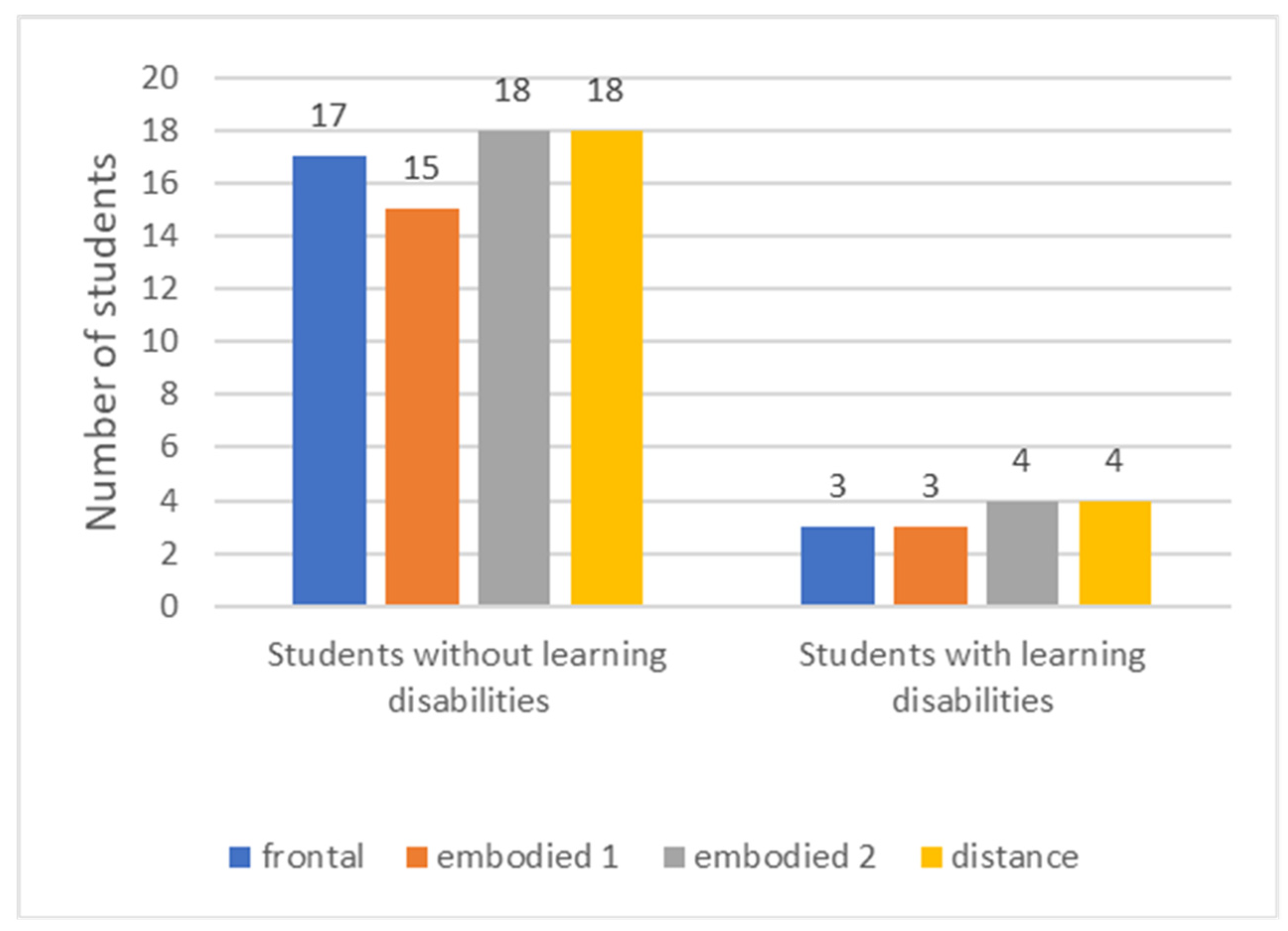
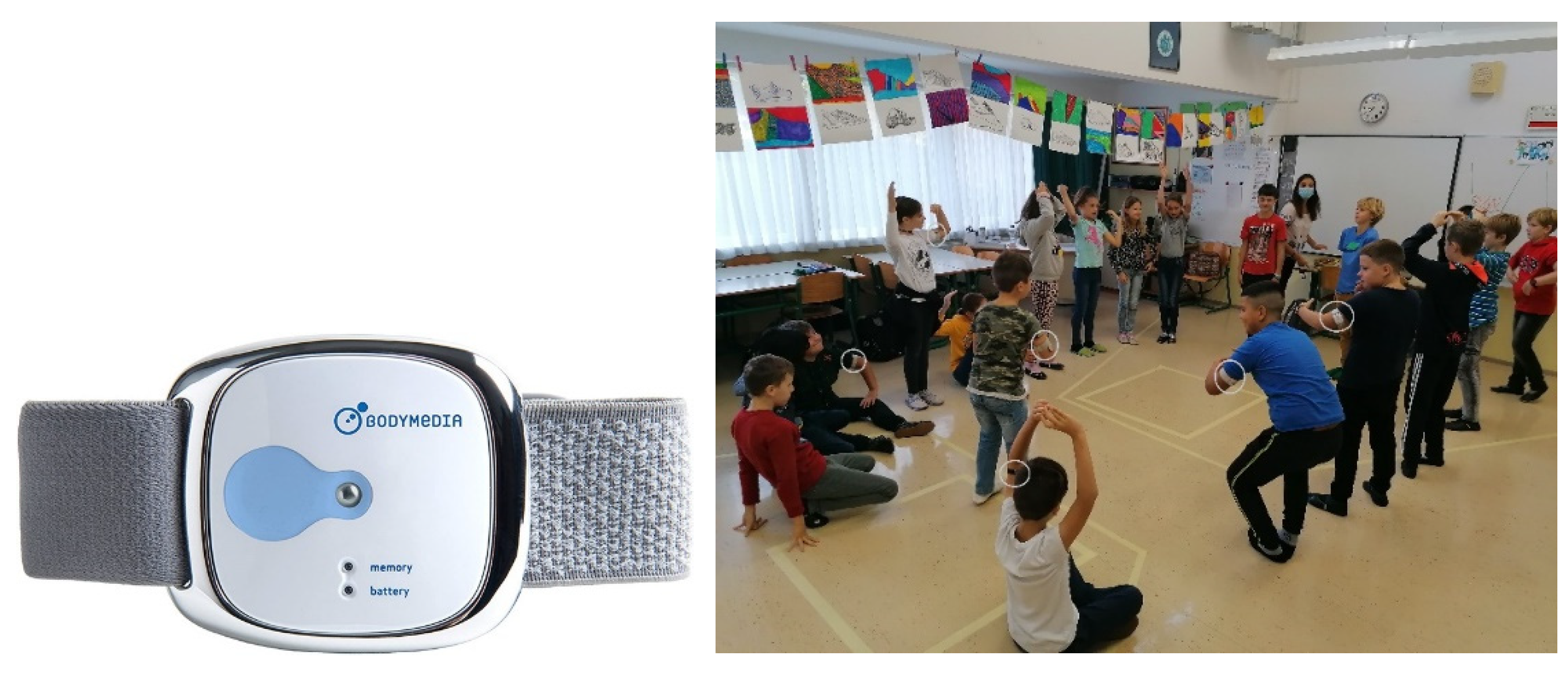

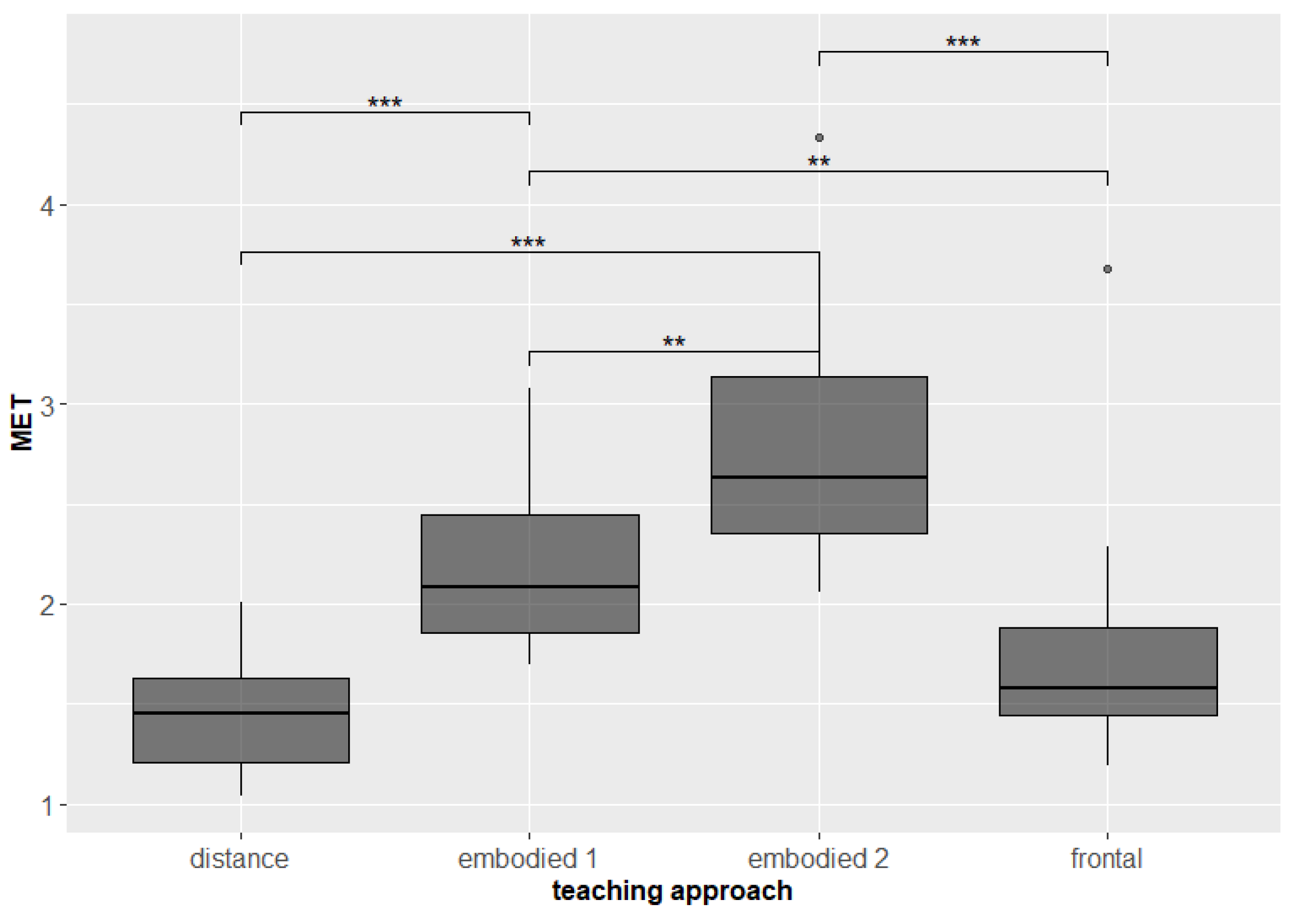
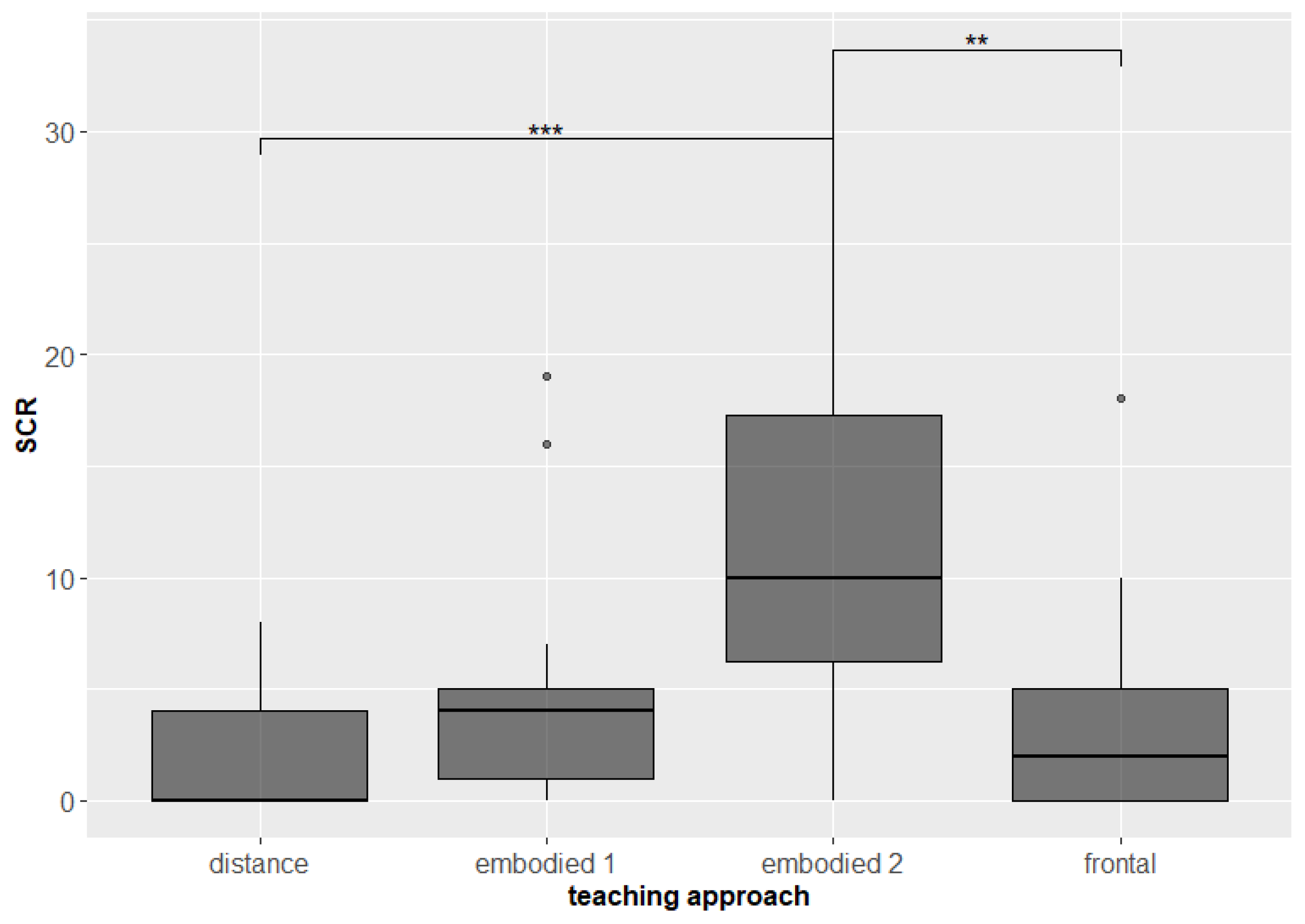
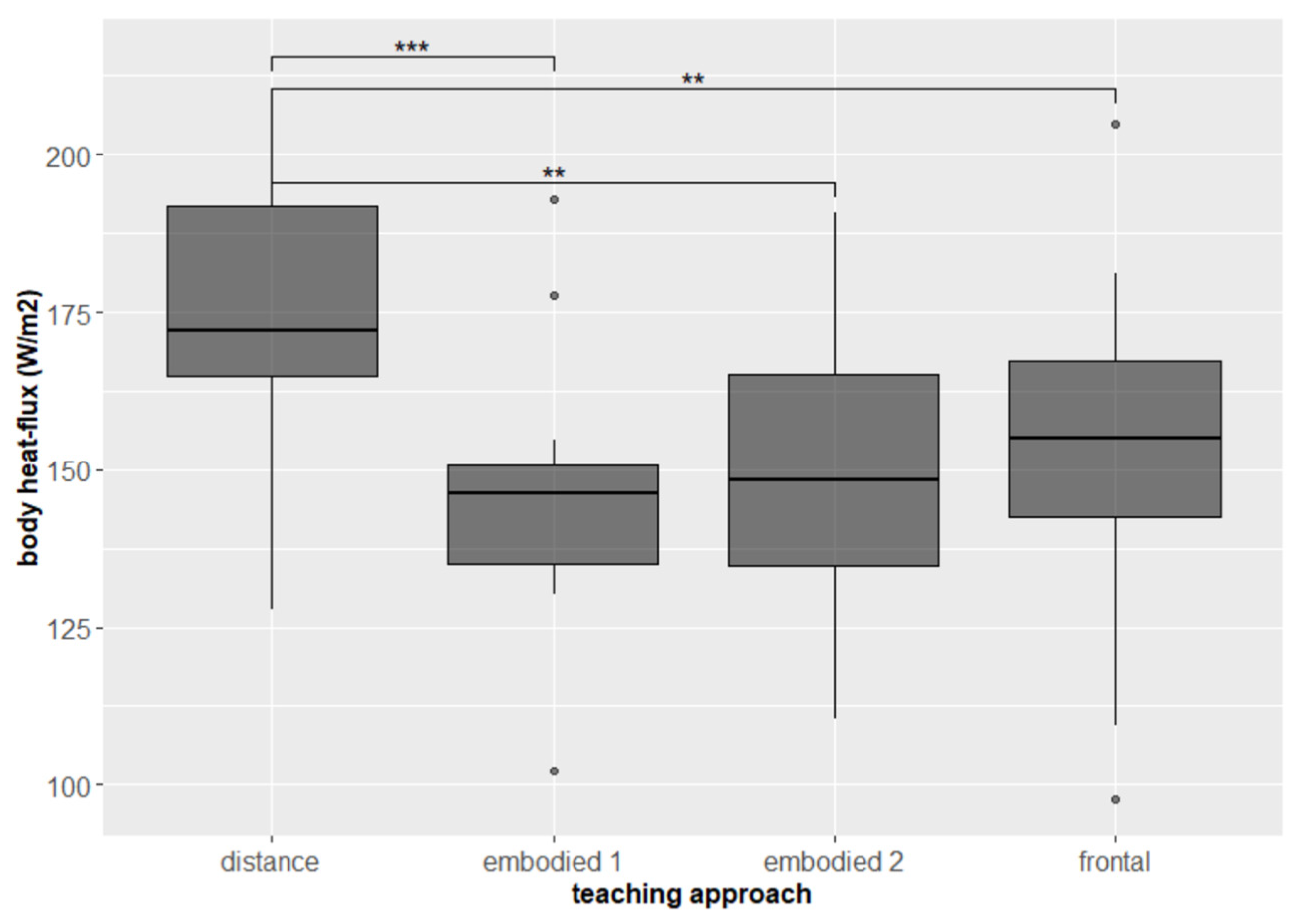



| Session | Topic | Teaching Approach | Difficulty | Content Description |
|---|---|---|---|---|
| 1 | Soil layers and pollution | Frontal (sedentary) | 3.6 | Presenting selected examples indicating direct and indirect soil pollution (e.g., traffic accidents, road salt). Demonstrating building and testing a water purification filter. Discussing in pairs and working with concrete material in groups. Elaboration of a mind map. |
| 2 | States of matter | Embodied | 3.8 | Demonstrating different states of water and the phase transitions with a demonstration experiment and creative movement in groups. Explaining mass of water in phase transitions. |
| 3 | Water cycle | Embodied | 3.1 | Presenting the water cycle in groups using creative movement with background music. Completing the water cycle chart. |
| 4 | Water on Earth | Distance (sedentary) | 2.7 | Watching a documentary film about surface water. Independently conducting an experiment. Discussing dilemmas and questions, including visuals and mime. Preparing the tabular presentation. |
| Topic Description | Number of Achieved Points (%) on Pre-Test | Number of Achieved Points (%) on Post-Test 1 | g1 | Number of Achieved Points (%) on Post-Test 2 | g2 | ||||||||
|---|---|---|---|---|---|---|---|---|---|---|---|---|---|
| n | M | SD | n | M | SD | M | SD | n | M | SD | M | SD | |
| Soil layers and pollution (frontal) | 23 | 50.3 | 21.0 | 21 | 64.6 | 17.1 | 0.25 | 0.37 | 24 | 61.5 | 15.6 | −0.21 | 0.7 |
| States of matter (embodied 1) | 20 | 29.6 | 19.8 | 19 | 55.0 | 26.1 | 0.40 | 0.31 | 24 | 42.0 | 19.1 | −0.35 | 0.6 |
| Water cycle (embodied 2) | 20 | 34.1 | 14.6 | 19 | 67.5 | 26.7 | 0.57 | 0.30 | 24 | 49.3 | 30.9 | −0.48 | 0.9 |
| Water on Earth (distance) | 20 | 40.5 | 16.3 | 25 | 67.6 | 21.8 | 0.44 | 0.33 | 22 | 59.6 | 23.3 | −0.44 | 1.1 |
Publisher’s Note: MDPI stays neutral with regard to jurisdictional claims in published maps and institutional affiliations. |
© 2022 by the authors. Licensee MDPI, Basel, Switzerland. This article is an open access article distributed under the terms and conditions of the Creative Commons Attribution (CC BY) license (https://creativecommons.org/licenses/by/4.0/).
Share and Cite
Geršak, V.; Giber, T.; Geršak, G.; Pavlin, J. Are Psychophysiological Wearables Suitable for Comparing Pedagogical Teaching Approaches? Sensors 2022, 22, 5704. https://doi.org/10.3390/s22155704
Geršak V, Giber T, Geršak G, Pavlin J. Are Psychophysiological Wearables Suitable for Comparing Pedagogical Teaching Approaches? Sensors. 2022; 22(15):5704. https://doi.org/10.3390/s22155704
Chicago/Turabian StyleGeršak, Vesna, Tina Giber, Gregor Geršak, and Jerneja Pavlin. 2022. "Are Psychophysiological Wearables Suitable for Comparing Pedagogical Teaching Approaches?" Sensors 22, no. 15: 5704. https://doi.org/10.3390/s22155704
APA StyleGeršak, V., Giber, T., Geršak, G., & Pavlin, J. (2022). Are Psychophysiological Wearables Suitable for Comparing Pedagogical Teaching Approaches? Sensors, 22(15), 5704. https://doi.org/10.3390/s22155704






